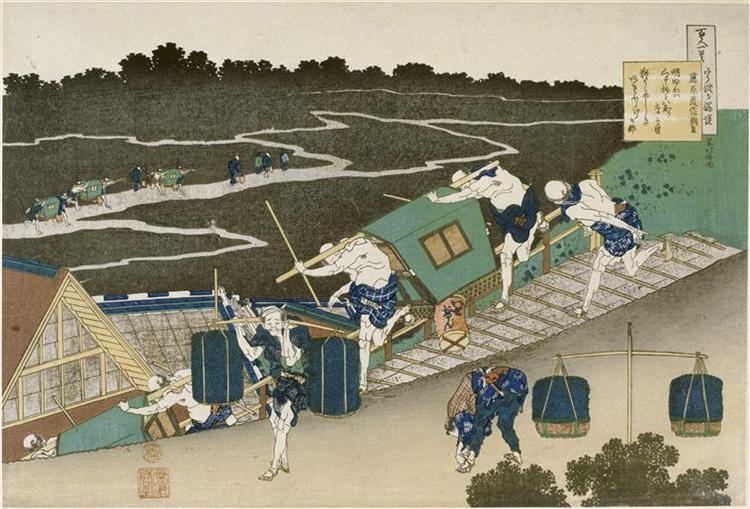Description
Katsushika Hokusai's "Fujiwara No Ason Michinobu" is a fascinating example of ukiyo-e, a style of printmaking and painting that flourished in Japan during the 18th and 19th centuries. Renowned for his mastery of capturing the ephemeral beauty of everyday life and nature, Hokusai presents a distinctive approach in this piece that combines the historical with richly nuanced visual aesthetics.
At the center of the composition, Hokusai depicts Fujiwara no Ason Michinobu, an iconic figure in Japanese literary history, who stands out most notably thanks to his elaborate clothing and contemplative expression. The use of layers of color in his attire, where shades of blue and pink predominate, not only highlights his noble status, but also reflects Hokusai’s technical skill in applying colors that have a vibrant and harmonious effect. The meticulousness of the details on the kimono shows the artist’s dedication to depicting the Japanese culture of the time, as well as his expertise in the use of patterns and textures.
The painting’s background is equally captivating. A subtle, natural landscape is hinted at, evoking the connection between man and nature, a constant theme in Hokusai’s art. The fluid lines that trace the mountains and sky not only frame Michinobu, but also provide a sense of depth and movement that contrasts with the stillness of the character. This use of negative space is a master technique that emphasizes the protagonist’s isolation and introspection, qualities that Hokusai often incorporates in his work.
The color palette used in “Fujiwara No Ason Michinobu” is representative of Hokusai’s style. The soft tones and subtle transitions between colors demonstrate his innovation in printing technique, pioneering the creation of gradient effects that bring an almost palpable life to images. This feature is part of the artist’s broader approach to exploring the relationship between color and emotion, allowing the viewer to feel the intensity of the atmosphere surrounding the character.
Delving into the context of the work, it is important to highlight that Hokusai moved in a Japan that, under the Tokugawa shogunate, experienced an unprecedented cultural and artistic flourishing. "Fujiwara No Ason Michinobu" embodies admiration for classical literature and nostalgia for the past, recurring themes in the art of the time. This work could be considered a tribute to traditional values and aesthetics, contrasting the imminent modernization of the country.
Looking at the work, it is clear that through his visual elements and subject matter, Hokusai not only protected Japanese cultural identity, but also placed his characters in settings that invite reflection and contemplation. This painting, with its complexity and beauty, thus becomes an artistic statement of the duality between the individual and the environment, as well as a testament to the richness of Japanese cultural heritage. As a whole, “Fujiwara No Ason Michinobu” stands as a cardinal work that encapsulates the essence of ukiyo-e and Hokusai’s genius, providing the viewer with a window into a time, place and vision that still resonates in contemporary art.
KUADROS ©, a famous painting on your wall.
Hand-made oil painting reproductions, with the quality of professional artists and the distinctive seal of KUADROS ©.
Painting reproduction service with satisfaction guarantee. If you are not completely satisfied with the replica of your painting, we will refund 100% of your money.

